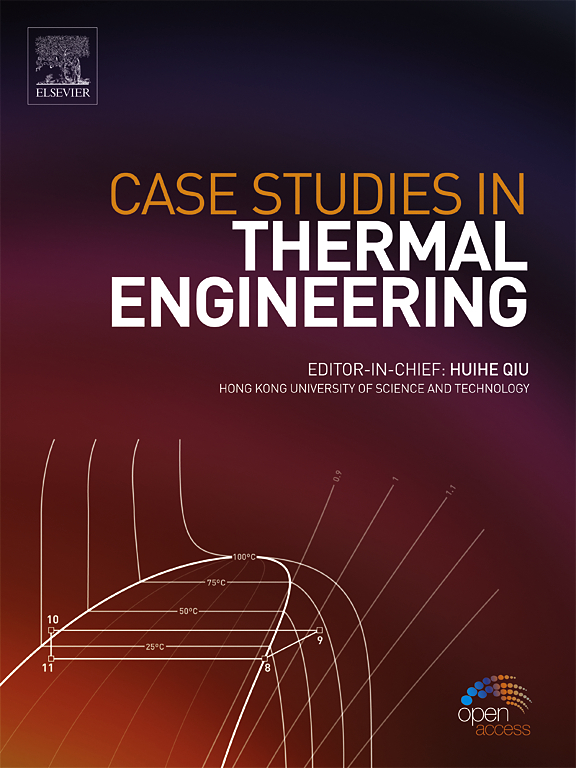Thermal performance enhancement of laminar flow using compound twisted square duct and variable pitch twisted tape inserts
IF 6.4
2区 工程技术
Q1 THERMODYNAMICS
引用次数: 0
Abstract
This study involves a computational analysis to find the effectiveness of incorporating twisted tape within a twisted square duct for improving heat transfer, focusing on laminar single-phase flow. The primary goal is to study how varying the tape pitch (y) influences the hydrothermal performance of this system. The twisted square duct pitch (S) and twist ratio (H) were kept constant. The numerical analysis is performed under conditions of uniform wall temperature, and varying the pitch ratio (y/S) across values of 0.25, 0.5,0.75, 1, 1.25, 1.5 and 1.75. The obtained findings suggest that the addition of twisted tape within the twisted square duct results in a greater rate of heat exchange and pressure drop relative to the simple twisted square duct. Research reveals that despite a higher rate of heat transfer for a pitch ratio of 0.25 the increased friction factor results in less effective thermal performance compared to the cases with pitch ratios of 0.75 and 0.5. The thermal performance factor reaches its peak at 1.32, corresponding to the Reynolds number 1000 for a pitch ratio of 0.75 case. Conversely, the lowest thermal performance factor value of 0.89 is observed at the Reynolds number 500 for pitch ratio 1.25 case.
利用复合扭绞方形风管和可变间距扭绞带插入件提高层流的热性能
本研究涉及计算分析,以层流单相流为重点,找出在扭曲的方形管道中加入扭曲带以改善传热的有效性。主要目的是研究改变胶带间距(y)如何影响该系统的水热性能。扭曲的方形管道间距 (S) 和扭曲比 (H) 保持不变。数值分析是在壁温均匀的条件下进行的,间距比(y/S)在 0.25、0.5、0.75、1、1.25、1.5 和 1.75 之间变化。研究结果表明,与简单的扭曲方形风管相比,在扭曲方形风管中添加扭曲带会导致更高的热交换率和压降。研究表明,尽管间距比为 0.25 的热传导率更高,但与间距比为 0.75 和 0.5 的情况相比,摩擦因数的增加导致热性能效率降低。热性能系数在 1.32 时达到峰值,对应于间距比为 0.75 时的雷诺数 1000。相反,间距比为 1.25 的情况下,雷诺数为 500 时的热性能系数最低,为 0.89。
本文章由计算机程序翻译,如有差异,请以英文原文为准。
求助全文
约1分钟内获得全文
求助全文
来源期刊

Case Studies in Thermal Engineering
Chemical Engineering-Fluid Flow and Transfer Processes
CiteScore
8.60
自引率
11.80%
发文量
812
审稿时长
76 days
期刊介绍:
Case Studies in Thermal Engineering provides a forum for the rapid publication of short, structured Case Studies in Thermal Engineering and related Short Communications. It provides an essential compendium of case studies for researchers and practitioners in the field of thermal engineering and others who are interested in aspects of thermal engineering cases that could affect other engineering processes. The journal not only publishes new and novel case studies, but also provides a forum for the publication of high quality descriptions of classic thermal engineering problems. The scope of the journal includes case studies of thermal engineering problems in components, devices and systems using existing experimental and numerical techniques in the areas of mechanical, aerospace, chemical, medical, thermal management for electronics, heat exchangers, regeneration, solar thermal energy, thermal storage, building energy conservation, and power generation. Case studies of thermal problems in other areas will also be considered.
 求助内容:
求助内容: 应助结果提醒方式:
应助结果提醒方式:


